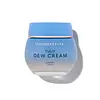What's inside
What's inside
 Key Ingredients
Key Ingredients

 Benefits
Benefits

 Concerns
Concerns

No concerns
 Ingredients Side-by-side
Ingredients Side-by-side

Water
Skin ConditioningDicaprylyl Carbonate
EmollientCetearyl Isononanoate
EmollientGlycerin
HumectantPentylene Glycol
Skin ConditioningCetearyl Alcohol
EmollientSteareth-20
CleansingSafflower Oil/Palm Oil Aminopropanediol Esters
Skin ConditioningLaminaria Digitata Extract
Skin ProtectingOpuntia Ficus-Indica Stem Extract
Skin ConditioningArabidopsis Thaliana Extract
AntioxidantMarrubium Vulgare Meristem Cell Culture
Skin ProtectingLeontopodium Alpinum Meristem Cell Culture
Skin ConditioningRetinyl Palmitate
Skin ConditioningTocopheryl Acetate
AntioxidantTocopherol
AntioxidantMicrococcus Lysate
Skin ConditioningCaprylyl Glycol
EmollientHexylene Glycol
EmulsifyingLactose
HumectantGalactoarabinan
Lecithin
EmollientSchizophyllan
HumectantBeta-Glucan
Skin Conditioning1,2-Hexanediol
Skin ConditioningCarbomer
Emulsion StabilisingCellulose
AbsorbentMaltodextrin
AbsorbentC14-22 Alcohols
Emulsion StabilisingCetearyl Glucoside
EmulsifyingC12-20 Alkyl Glucoside
EmulsifyingHydroxypropyl Methylcellulose
Emulsion StabilisingDisodium EDTA
Sodium Hydroxide
BufferingPhenoxyethanol
PreservativeEthylhexylglycerin
Skin ConditioningSodium Benzoate
MaskingParfum
MaskingCI 77007
Cosmetic ColorantLimonene
PerfumingWater, Dicaprylyl Carbonate, Cetearyl Isononanoate, Glycerin, Pentylene Glycol, Cetearyl Alcohol, Steareth-20, Safflower Oil/Palm Oil Aminopropanediol Esters, Laminaria Digitata Extract, Opuntia Ficus-Indica Stem Extract, Arabidopsis Thaliana Extract, Marrubium Vulgare Meristem Cell Culture, Leontopodium Alpinum Meristem Cell Culture, Retinyl Palmitate, Tocopheryl Acetate, Tocopherol, Micrococcus Lysate, Caprylyl Glycol, Hexylene Glycol, Lactose, Galactoarabinan, Lecithin, Schizophyllan, Beta-Glucan, 1,2-Hexanediol, Carbomer, Cellulose, Maltodextrin, C14-22 Alcohols, Cetearyl Glucoside, C12-20 Alkyl Glucoside, Hydroxypropyl Methylcellulose, Disodium EDTA, Sodium Hydroxide, Phenoxyethanol, Ethylhexylglycerin, Sodium Benzoate, Parfum, CI 77007, Limonene
Water
Skin ConditioningCoco-Caprylate/Caprate
EmollientSqualane
EmollientHelianthus Annuus Seed Oil
EmollientNiacinamide
SmoothingPropanediol
SolventGlyceryl Stearate
EmollientSodium Starch Octenylsuccinate
AbsorbentSclerotium Gum
Emulsion StabilisingTocopheryl Acetate
AntioxidantTulipa Hybrid Flower Extract
Skin ConditioningHydrolyzed Sodium Hyaluronate
Skin ConditioningSodium Hyaluronate
HumectantGlycerin
HumectantPanthenol
Skin ConditioningGluconolactone
Skin Conditioning3-O-Ethyl Ascorbic Acid
Skin ConditioningSimmondsia Chinensis Seed Oil
EmollientArginine
MaskingVitis Vinifera Seed Oil
EmollientDaucus Carota Sativa Seed Oil
EmollientAscorbyl Palmitate
AntioxidantCucurbita Pepo Seed Extract
Skin ConditioningPyrus Malus Fruit Extract
Skin ConditioningDaucus Carota Sativa Root Extract
Skin ConditioningCalcium Gluconate
HumectantHydroxypropyl Starch Phosphate
Caprylyl Glycol
EmollientSodium Gluconate
Skin ConditioningSodium Lactate
BufferingSodium Benzoate
MaskingCitric Acid
BufferingPotassium Sorbate
PreservativePhenethyl Alcohol
MaskingWater, Coco-Caprylate/Caprate, Squalane, Helianthus Annuus Seed Oil, Niacinamide, Propanediol, Glyceryl Stearate, Sodium Starch Octenylsuccinate, Sclerotium Gum, Tocopheryl Acetate, Tulipa Hybrid Flower Extract, Hydrolyzed Sodium Hyaluronate, Sodium Hyaluronate, Glycerin, Panthenol, Gluconolactone, 3-O-Ethyl Ascorbic Acid, Simmondsia Chinensis Seed Oil, Arginine, Vitis Vinifera Seed Oil, Daucus Carota Sativa Seed Oil, Ascorbyl Palmitate, Cucurbita Pepo Seed Extract, Pyrus Malus Fruit Extract, Daucus Carota Sativa Root Extract, Calcium Gluconate, Hydroxypropyl Starch Phosphate, Caprylyl Glycol, Sodium Gluconate, Sodium Lactate, Sodium Benzoate, Citric Acid, Potassium Sorbate, Phenethyl Alcohol
 Reviews
Reviews

Ingredients Explained
These ingredients are found in both products.
Ingredients higher up in an ingredient list are typically present in a larger amount.
Caprylyl Glycol is a humectant and emollient, meaning it attracts and preserves moisture.
It is a common ingredient in many products, especially those designed to hydrate skin. The primary benefits are retaining moisture, skin softening, and promoting a healthy skin barrier.
Though Caprylyl Glycol is an alcohol derived from fatty acids, it is not the kind that can dry out skin.
This ingredient is also used as a preservative to extend the life of products. It has slight antimicrobial properties.
Learn more about Caprylyl GlycolGlycerin is already naturally found in your skin. It helps moisturize and protect your skin.
A study from 2016 found glycerin to be more effective as a humectant than AHAs and hyaluronic acid.
As a humectant, it helps the skin stay hydrated by pulling moisture to your skin. The low molecular weight of glycerin allows it to pull moisture into the deeper layers of your skin.
Hydrated skin improves your skin barrier; Your skin barrier helps protect against irritants and bacteria.
Glycerin has also been found to have antimicrobial and antiviral properties. Due to these properties, glycerin is often used in wound and burn treatments.
In cosmetics, glycerin is usually derived from plants such as soybean or palm. However, it can also be sourced from animals, such as tallow or animal fat.
This ingredient is organic, colorless, odorless, and non-toxic.
Glycerin is the name for this ingredient in American English. British English uses Glycerol/Glycerine.
Learn more about GlycerinSodium Benzoate is a preservative. It's used in both cosmetic and food products to inhibit the growth of mold and bacteria. It is typically produced synthetically.
Both the US FDA and EU Health Committee have approved the use of sodium benzoate. In the US, levels of 0.1% (of the total product) are allowed.
Sodium benzoate works as a preservative by inhibiting the growth of bacteria inside of cells. It prevents the cell from fermenting a type of sugar using an enzyme called phosphofructokinase.
It is the salt of benzoic acid. Foods containing sodium benzoate include soda, salad dressings, condiments, fruit juices, wines, and snack foods.
Studies for using ascorbic acid and sodium benzoate in cosmetics are lacking, especially in skincare routines with multiple steps.
We always recommend speaking with a professional, such as a dermatologist, if you have any concerns.
Learn more about Sodium BenzoateTocopheryl Acetate is AKA Vitamin E. It is an antioxidant and protects your skin from free radicals. Free radicals damage the skin by breaking down collagen.
One study found using Tocopheryl Acetate with Vitamin C decreased the number of sunburned cells.
Tocopheryl Acetate is commonly found in both skincare and dietary supplements.
Learn more about Tocopheryl AcetateWater. It's the most common cosmetic ingredient of all. You'll usually see it at the top of ingredient lists, meaning that it makes up the largest part of the product.
So why is it so popular? Water most often acts as a solvent - this means that it helps dissolve other ingredients into the formulation.
You'll also recognize water as that liquid we all need to stay alive. If you see this, drink a glass of water. Stay hydrated!
Learn more about Water